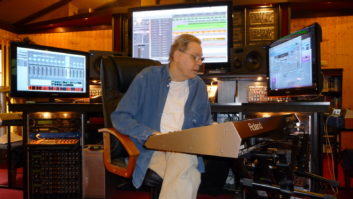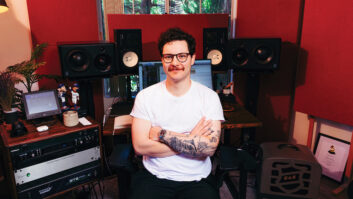Grammy-winning violinist, composer and educator Mark O’Connor released his new album MOC4 in June, part of his lifelong mission of bringing the violin and other stringed instruments back to the prominence in our culture they once enjoyed. O’Connor has been a huge influence on string players of all ages both in the U.S. and abroad.
MOC4 showcases O’Connor playing an incredibly diverse collection of music alongside many of the people he has mentored over the years, including Bela Fleck and My Morning Jacket-collaborator Jeremy Kittel, Ahn Trio member Angella Ahn and 2013 Downbeat magazine’s “Rising Star,” Sara Caswell. Over the 40 years he has been a recording artist, O’Connor has learned a thing or two about recording the violin. Pro Sound News took a moment to speak to O’Connor amid his busy touring schedule.
ON ‘BRINGING BACK THE VIOLIN’:
Historically, the violin has been a great instrument and very important in both European and Early American music culture from the beginning. It was the first instrument that the blues was played on—from the voice to the instrument. Also, it was an everyday instrument that both the elite and the masses played and enjoyed.
I want the violin to be in the center of music again. I am of the strong belief that the single reason the violin has dropped in popularity in our culture over the last 50 years is because of the way it has been taught. It has been taught in a way that is very limiting to musicianship, creativity and improvisation. Other instruments being taught in our culture, such as guitar, keyboards, percussion and voice, all create a ‘musician pool’ that is able to contribute to our culture.
ON CHOOSING MATERIAL:
The album is a direct result of my new book, O’Connor Method Book IV, which was created as a lesson plan for the advanced student. My belief is that people should learn how to play the blues, a spiritual or a hoedown. Those are the kinds of things that are showcased in my lesson plans and the album is a direct reflection of that ethos. The material on the album itself spans thousands of years, and there is a different criterion in how I chose it. I have to decide what material I feel is important enough in our culture.
I was exposed to a lot of the great legends growing up—for example, the great singers and the great jazz players. I was around a lot of these people that basically created the repertoire. I gained insight from a student’s perspective, and then later I got it from a teaching perspective. I saw material resonate across a few generations, and I knew what material resonated with my teachers in the 1920s and 30s when they were playing professionally. I also knew what materials were resonating when I was coming up in the 1960s and 70s, and I know what materials are resonating now when children are starting to learn music. So I have a hundred-year perspective and I don’t have to read the history books about it. This is the pot that I am drawing material out of.
ON ‘SOLO PRODUCING’:
I produced MC04, and have been producing my own albums for a long time. For some projects, I will bring in another set of ears and co-produce; for example when I am working with orchestras where we are on the clock or when we may not have much time in the studio. As for myself, I am confident producing something straight from the studio floor while I am playing, and am able to concentrate on the performance while hearing every single mistake of my other players. I’m able to consider my performance and at the very same time consider the performance of others.
ON MICROPHONES:
I chose the studio right near 54th in Manhattan, Sean Swinney Recording. What you are hearing on MOC4 from the violin perspective is an old 1953 Neumann M 49. I also used my original Heroes album 20 years ago where I played alongside my mentors. That is one of the things that is so neat about MOC 4 is that I am turning the tables and playing with people that I mentored.
I usually place the M 49s about three feet out. When I do solos, I place them in a stereo configuration. We usually mic up the room as well, and for this we will use the AKG C12s or C24s. The AKGs are also used on accompany instruments, such as the piano or the guitars. In both of these applications, we used the C12s. I’ve been using this set of mics for a long time, and anytime I deviate away from this and hear an album where I’ve tried something else, I’ll always grit my teeth and wonder why I switched.
ON REVERBS AND HALLS:
If I had the budget of a lifetime every time I recorded, I wouldn’t record in a studio—I would record in a concert hall. But of course you have to balance studio quality versus convenience, timing and all of that. The reverb unit I use is called a Bricasti Design N7 Stereo Reverb Processor. This reverb captures samples of various concert halls that I’ve played in. For example, it has the very best concert hall I have recorded in, called Mechanics Hall, in Worcester, MA. I recorded three major albums there— including the Appalachian Journey, which won a Grammy, and it is by far the best sound I have ever gotten on my violin.







